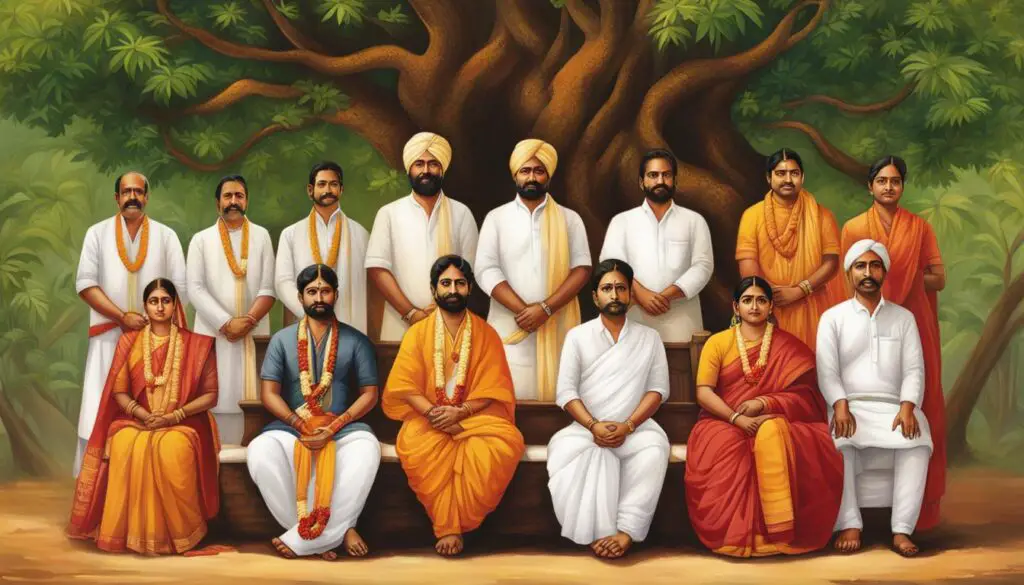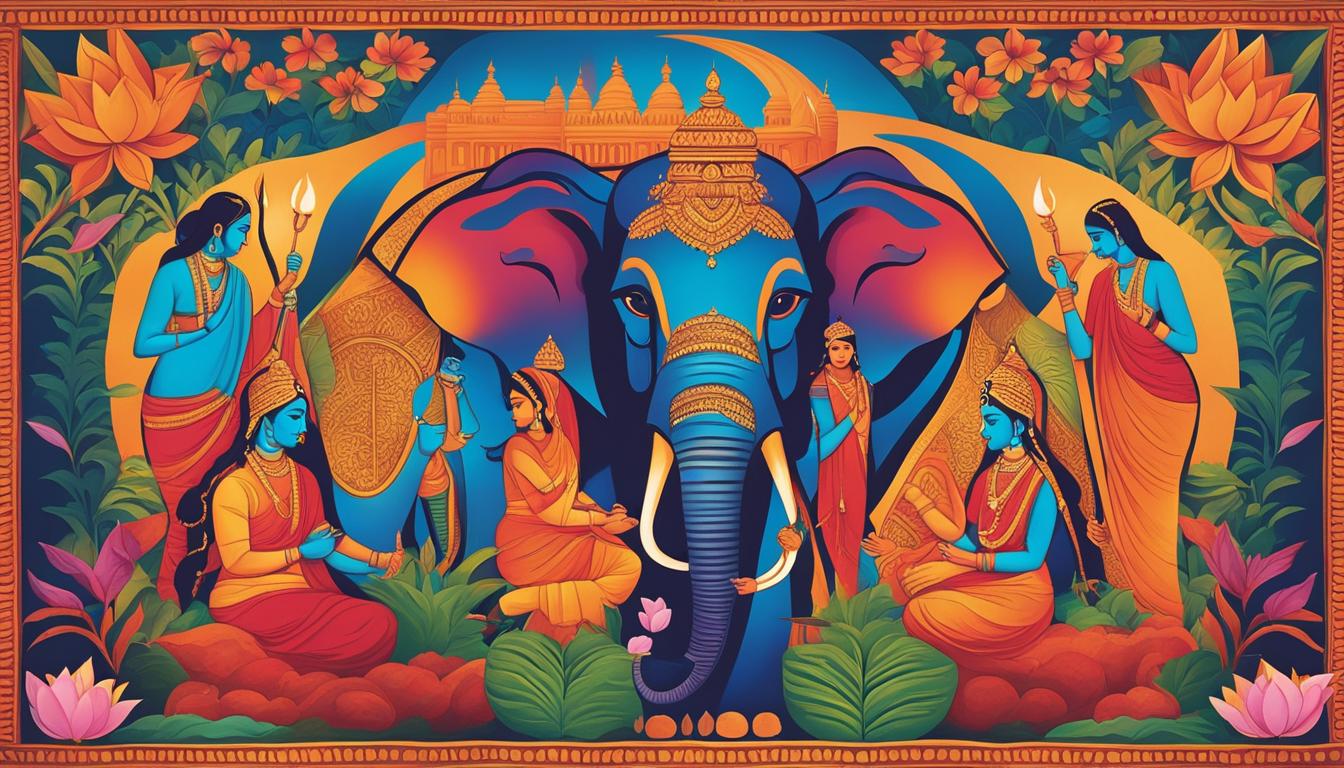Welcome to our article on the Aruvippuram Movement, one of India’s most influential socio-religious reform movements. Led by Sri Narayana Guru, this movement challenged the Brahmanical tradition and aimed to bring about social and spiritual transformation in India. In this article, we will explore the impact of the Aruvippuram Movement and the key figures and organizations involved. Let’s dive in!
Key Takeaways:
- The Aruvippuram Movement was a significant socio-religious reform movement in India led by Sri Narayana Guru.
- Narayana Guru challenged the Brahmanical tradition and advocated for social equality and the rights of marginalized communities.
- The movement aimed to promote social and spiritual regeneration, challenge the caste system, and uplift the Ezhava community.
- Key figures like Ayyankali, Chattampi Swamigal, and organizations like SNDP played vital roles in the Aruvippuram Movement.
- The movement had a lasting impact on Indian society, promoting inclusivity, education, and the eradication of caste-based discrimination.
Key Figures and Organizations of the Aruvippuram Movement
The Aruvippuram Movement witnessed the involvement of several key figures and organizations who played crucial roles in advancing the cause of social reform and empowerment. These individuals and groups contributed significantly to challenging social inequalities and advocating for a more inclusive society. Let’s explore some of the prominent figures and organizations associated with the Aruvippuram Movement:
Sri Narayana Guru
Sri Narayana Guru, the revered founder of the Aruvippuram Movement, was a visionary leader who emphasized social equality and unity among all communities. He vehemently opposed caste distinctions and worked tirelessly to promote education and trade as means of empowerment. Sri Narayana Guru’s teachings continue to inspire generations and are deeply ingrained in the movement’s core principles.
Sree Narayana Dharma Paripalana Yogam (SNDP)
The Sree Narayana Dharma Paripalana Yogam (SNDP) was established in 1903 with the goal of propagating Sri Narayana Guru’s teachings and fostering the upliftment of the Ezhava community and other backward communities. The SNDP played a pivotal role in organizing social and educational initiatives, working towards social reform, and advocating for the rights of marginalized sections of society.
Ayyankali
Ayyankali, a prominent social reformer and activist, dedicated his life to the emancipation of the Pulaya community. He championed the rights of the oppressed and fought against social discrimination. Ayyankali’s efforts left an indelible mark on the Aruvippuram Movement, contributing to the broader struggle for social justice and equality.
Chattampi Swamigal
Chattampi Swamigal, an influential reformer, worked relentlessly to eradicate the deeply entrenched practice of untouchability. He emphasized the importance of social harmony and unity, striving for a society free from discrimination. Chattampi Swamigal’s contributions had a lasting impact on the Aruvippuram Movement’s objectives and philosophy.
Pandit Karuppan
Pandit Karuppan was a pioneering figure in the Aruvippuram Movement, dedicated to breaking down social inequalities prevalent in his community. He actively fought against conservative practices and cultural restrictions, advocating for progressive reforms. Pandit Karuppan’s unwavering commitment to social justice and equality profoundly influenced the movement.
Mannathu Padmanabhan
Mannathu Padmanabhan, another key figure in the Aruvippuram Movement, fought against social injustices through his efforts in uplifting the Nair community and advocating for their rights. His leadership in organizations such as the Nair Service Society significantly contributed to the broader goals of the movement.
V.T.Bhattathirippad
V.T.Bhattathirippad, a prominent social reformer and politician, played a vital role in challenging traditional conventions and advocating for progressive reforms within his community. His contributions to the Aruvippuram Movement reflected his unwavering commitment to social equality and justice.
The Aruvippuram Movement owes much of its success to these key figures and organizations, who dedicated their lives to fighting against social inequalities and fostering a more inclusive society.

**Table: Contribution of Key Figures and Organizations in the Aruvippuram Movement**
| Key Figures/Organizations | Contributions |
|—————————|—————|
| Sri Narayana Guru | Emphasized social equality, opposed caste distinctions, advocated for education and trade |
| Sree Narayana Dharma Paripalana Yogam (SNDP) | Promoted Narayana Guru’s teachings, upliftment of Ezhava community, and other backward communities |
| Ayyankali | Fought for the rights and emancipation of the Pulaya community |
| Chattampi Swamigal | Worked to eradicate untouchability and promote social harmony |
| Pandit Karuppan | Fought against social inequalities and conservatism in his community |
| Mannathu Padmanabhan | Advocated for the rights and upliftment of the Nair community |
| V.T.Bhattathirippad | Challenged traditional conventions and fought for social equality |
Note: The table presents a summary of the contributions made by key figures and organizations in the Aruvippuram Movement. It depicts their efforts to challenge social inequalities, promote social harmony, and uplift marginalized communities.
Conclusion
The Aruvippuram Movement had a profound impact on Indian society, bringing about significant socio-religious reform and empowering marginalized communities. Led by Sri Narayana Guru and supported by organizations like the SNDP, the movement played a vital role in advocating for social equality, education, and the eradication of caste-based discrimination.
The teachings and initiatives of the Aruvippuram Movement continue to resonate in India today, serving as a catalyst for inclusivity, justice, and progress. This remarkable chapter in India’s history of socio-religious reform has fostered a more equitable and inclusive society, promoting the empowerment of marginalized communities across the nation.
Through its unwavering commitment to social transformation, the Aruvippuram Movement has paved the way for the upliftment and empowerment of individuals previously marginalized and oppressed. By challenging age-old norms and advocating for the rights of all individuals, the movement has played a crucial role in shaping the social fabric of India, leaving a lasting impact on future generations.
The Aruvippuram Movement stands as a testament to the power of collective activism and the unwavering pursuit of social justice. Its influence and legacy serve as a reminder of the ongoing struggle for a more egalitarian society, inspiring individuals and organizations to continue working towards the well-being and empowerment of all.
FAQ
What was the Aruvippuram Movement?
The Aruvippuram Movement was a significant socio-religious reform movement in India led by Sri Narayana Guru. It aimed to challenge the caste system, promote social and spiritual regeneration, and advocate for the rights of marginalized communities.
Who were the key figures and organizations involved in the Aruvippuram Movement?
The key figures in the Aruvippuram Movement included Sri Narayana Guru, who founded the movement and emphasized social equality. The Sree Narayana Dharma Paripalana Yogam (SNDP), established in 1903, worked towards the upliftment of the Ezhava community and other backward communities. Ayyankali, Chattampi Swamigal, Pandit Karuppan, Mannathu Padmanabhan, and V.T.Bhattathirippad were also influential figures fighting against social inequalities and conservatism.
What impact did the Aruvippuram Movement have on Indian society?
The Aruvippuram Movement had a significant impact on Indian society in terms of socio-religious reform and the empowerment of marginalized communities. It brought attention to the need for social equality, education, and the eradication of caste-based discrimination. The teachings and initiatives of the movement continue to inspire and shape the social fabric of India today, promoting inclusivity, justice, and progress for all.

